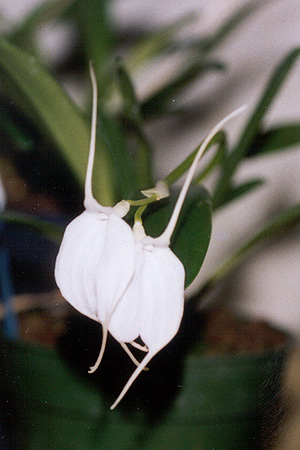Masdevallia tovarensis facts for kids
Quick facts for kids Masdevallia tovarensis |
|
|---|---|
 |
|
| Scientific classification | |
| Genus: |
Masdevallia
|
| Species: |
tovarensis
|
| Synonyms | |
|
Masdevallia candida Klotzsch & H.Karst. ex Rchb.f. |
|
Masdevallia tovarensis is a beautiful type of orchid that grows only in northern Venezuela. This means it is endemic to that specific region and cannot be found naturally anywhere else in the world. It is known for its bright white flowers, which make it stand out among other orchids.
Contents
About the Tovar Masdevallia Orchid
The Masdevallia tovarensis is a special plant. It belongs to a large family of orchids called Masdevallia. These orchids are often found in cool, misty mountain forests. They are known for their unique flower shapes and vibrant colors. The tovarensis part of its name comes from the Tovar Colony (Colonia Tovar) in Venezuela, where it was first discovered.
Where it Lives
This particular orchid thrives in the cool, humid cloud forests of northern Venezuela. It usually grows on trees or rocks, not in the soil. This way of growing is called "epiphytic" (on trees) or "lithophytic" (on rocks). These forests provide the perfect conditions for the orchid. They have plenty of moisture from fog and rain, and the temperatures are mild.
What it Looks Like
The Masdevallia tovarensis is famous for its stunning white flowers. Each flower has three sepals, which are like petals but are often fused together. These sepals form a tube-like shape that opens up at the end. The flowers are usually pure white, sometimes with a hint of yellow or green at the base. They grow on tall, slender stems that rise above the leaves. The leaves themselves are usually dark green and leathery.
How it Grows: Life Cycle
Like many orchids, Masdevallia tovarensis starts its life as a tiny seed. These seeds are very small, almost like dust. They need special fungi to help them sprout and grow. Once a seedling starts to grow, it develops roots that cling to trees or rocks. It absorbs water and nutrients from the air and rain.
As the plant matures, it forms new growths called "ramicauls." Each ramicaul produces a single leaf. When the plant is old enough, it will produce flower stems from the base of these ramicauls. The flowers typically bloom in the cooler months, often around late autumn or winter.
Reproduction
Orchids reproduce by producing seeds inside a fruit capsule after their flowers are pollinated. In nature, tiny insects or other animals might help pollinate the Masdevallia tovarensis flowers. Once the seeds are mature, the capsule splits open, releasing thousands of microscopic seeds into the wind. These seeds then float away, hoping to land in a suitable place to grow.
Because these orchids are so beautiful, people also grow them in special greenhouses. Here, they can be pollinated by hand to produce more plants. This helps to make sure that this lovely species continues to thrive.
See also
 In Spanish: Masdevallia tovarensis para niños
In Spanish: Masdevallia tovarensis para niños

